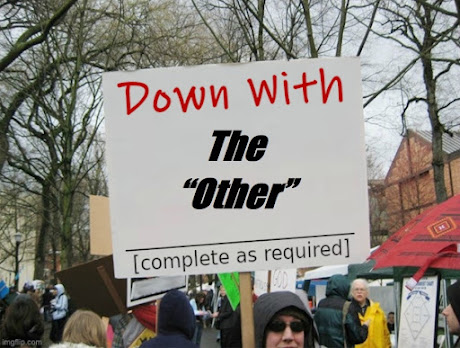When Fante Met Mingo...
In case you hadn't noticed by now, Noir of the 1950s found itself increasingly obsessed with "law-enforcement" types (Detectives, transit cops, postal inspectors) sometimes to the point of absurdity.
Last week's Appointment With Danger most definitely lives at the "absurd" end of the spectrum (with its bebop-loving floozy and its vaguely supercilious Nun) but it still reflects the mindset of the era; an era in which Law Enforcement was becoming increasingly unfettered in its zeal to eliminate undesirable elements of American society.
Alan Ladd's intrepid postal inspector isn't a noir protagonist so much as a comic book superhero, battling evil and smashing in heads wherever there is Foul Play going on.
We never have to fear for his safety, because he has Truth and Justice on his side (and a Nun to be his conscience!). Criminals, bank robbers and international Communists have no hope against this type of justice warrior.
This type of narrative was increasingly common in the authoritarian, Cold War atmosphere of the 1950s, and it was beginning to feel rather disconnected from the "Noir" classics of the previous decade. Double Indemnity; Criss Cross; Detour; Out of the Past... all inhabited a shadowy, dream world of loose ethics, looser women and hazy morals. Mid-Century noir drives an All-American steam-shovel through that dream world.
Sometimes.
As we are about to see, that shadowy dream world can sometimes come for the cops as well.
When The Big Combo was released (in 1955) it was dismissed by the New York Times film critic as "a shrill, clumsy and rather old-fashioned crime melodrama" and "a sputtering, misguided antique."
Posterity has not agreed with him. The Big Combo is remembered today as one of the most iconic noirs of all time, and arguably as one of the last great masterworks of the style.
If it felt like an "old fashioned antique" to a reviewer in 1955, that was probably because it was so thoroughly grounded in the style (if not the content) of an older era of noir.
Filmed almost entirely on sound stages, The Big Combo tells its story largely with light and shadow, making use of some of the juiciest black-and-white cinematography this side of German Expressionism (courtesy of the legendary John Alton).
And what a sleazy story it is.
Cornel Wilde plays Lieutenant Diamond, an exhausted, run-down cop who is pathologically obsessed with bringing down mob boss "Mr. Brown" (Richard Conte). But this is not the world of the Postal Inspector and the Nun, or even the world of William Holden's transit cop (from Union Station).
In The Big Combo, the Mob is all powerful, while the cops are exhausted, under-funded and over-stretched. Our hero may have law and order on his side, but Mr. Brown has the money, the connections and the charisma.
He also has Fante and Mingo, the most interesting (and human) professional killers of any film from this era.
Very clearly meant to be a gay couple, the film barely bothers to hide their relationship, which is paradoxically portrayed as the most wholesome and non-toxic relationship of the narrative.
1955 was of course still very much the era of the Hollywood blacklist, when writers, directors and performers were all living in constant terror of actual Government over-reach. The screenplay of The Big Combo is officially credited to Philip Yordan, but Yordan at this time was frequently working as a "front" for a number of blacklisted writers; putting his name on scripts that were actually written by colleagues who were otherwise unable to work.
Although there is no definitive information about the true authorship here, the screenplay appears to have been written by Ben Maddow, a blacklisted writer whose view of the current state of American society was understandably pessimistic and cynical.
This is not a world of cops and robbers; good guys and bad guys (and no one here is a Nun!). This is modern society at its murkiest and sleaziest, where nothing is completely clean or completely dirty.
If it felt "old fashioned" to the (rather tone deaf) New York Times critic, it's only because the film doesn't spend its entire running time spinning hagiographic praise for the dashing G-men on the front line of the culture wars. It's a much darker film than that.
It's "dark cinema". Or as the French used to say, "film noir."
We will screen The Big Combo at 7.30 on Thursday, the 5th of June at the Victoria Park Baptist Church.



















Goodness me, in the dressing room picture, just look at the size of her heels. They must be about 6 inches and with (I think) wedges in the front!
ReplyDeleteHa! Well, the film doesn't exactly tiptoe around the particulars of her profession, as you will see! Noir has always hinted at the seedy underbelly of society. The Big Combo blasts it out in neon lights...
DeleteTiptoe - Ha! So the film doesn't pussyfoot around then.
DeleteVery well-chosen word... Keep that in mind as you're watching the film...
Delete